
Captain Arthur Waite raced his supercharged Austin 7 to victory in the 1928 Australian Grand Prix on Victoria’s Phillip Island…
Here ‘The Skipper’ as his boys in the UK called him, on the far side of the car, and his Australian mechanic, Guy Barringer are preparing the racer behind the Isle of Wight Hotel in Cowes during the race weekend, 31 March 1928.
Billed at the time by the promoter, Victoria’s ‘Light Car Club’ as the ‘100 Miles Road Race’, ‘The First In Australia’ the event was run on a dirt-circuit laid out on the Islands roads, it later became recognised as the first Australian Grand Prix- the Victorian Light Car Club named subsequent events held at ‘Island from 1929-1935 as ‘The Australian Grand Prix’.
In more recent times the first AGP has been acknowledged by many as that held on 15 January 1927. It was a knockout speedway event held at the Goulburn, New South Wales horse racing track. The cars didn’t race ‘en masse’ but rather six competitors ran, two at a time in three heats, knockout fashion over 4 laps of a 1 mile and a bit oval track with the final decided by the fastest two competitors from the heats facing off over 6 laps- Geoff Meredith was the winner in his Bugatti T30. The circumstances around the discovery and recognition of the First Australian Grand Prix are briefly ventilated in this article; https://primotipo.com/2017/04/14/1936-australian-grand-prix-victor-harbour/
The 1928 ‘Island event was a road race held on a 6.5 mile dirt, rectangular course for cars of less than 2 litres spread across four engine capacity based classes- in two races, each race having two of the classes in it of 100 miles distance.
Twenty six ‘light car’ competitors entered with thirteen classified as finishers. The winner was the fastest overall- as in the competitor with the quickest race time from the two events of 100 miles, Captain Arthur Waite in his ‘works’ Austin 7 s/c won from JO McCutcheon aboard a Morris Cowley and CR Dickason in an Austin 12.

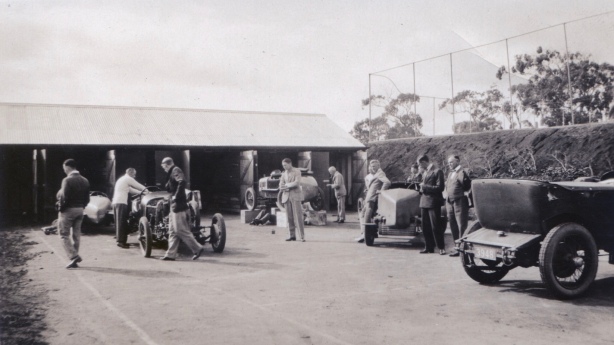
Historic European Context…
It is timely to look at motorsport in Australia in the context of what was happening globally at the time.
Motor racing commenced in France, the first ‘motoring contest’ took place on July 22, 1894, organised by a Paris newspaper, the Paris-Rouen Rally was 126 km from Paris to Rouen.
Count Jules Albert de Dion was first into Rouen after 6 hours 48 minutes, an average speed of 19 km/h (12 mph). The official winners were Peugeot and Panhard as cars were judged on their speed, handling and safety characteristics- De Dion’s steam car needed a stoker which the judges deemed to be outside their objectives…
And so commenced a period of racing unregulated cars on open roads between cities, this evolved after many deaths, from racing on open to closed road circuits. During the Paris-Madrid road race of 1903 a number of people, both drivers and pedestrians – including Marcel Renault were killed, as a result the race was stopped by French authorities at Bordeaux- further road based events were banned.
In the US the Gordon Bennett Races for the ‘Gordon Bennett Cup’ funded by American newspaper magnate James Gordon Bennett in commenced in 1900. Its formula was based around similar vehicles competing on closed roads but representation was limited to three teams per country, this disadvantaged France as the largest European motor manufacturer at the time.
When the French proposal to change representation in the 1905 Gordon Bennett failed they used the chance to host the 1906 event, a privilege to the previous years winner, to hold the alternative ‘Grand Prix de l’ACF’. The French Grand Prix was held on 26 June 1906 over a 103 Km roughly triangular road circuit near Sarthe, the winner of the 1238 Km, event, held over 6 laps of the 103 Km course on two days was Hungarian Ferenc Szisz in a Renault.
In the US, William Vanderbilt launched the Vanderbilt Cup at Long Island, New York in 1904.
Races at the time were heavily nationalistic, with a few countries setting up races of their own, but there was no formal championship tying them together. Rules varied from country to country and race to race, and typically centred on maximum (not minimum) weights in an effort to limit power by limiting engine size indirectly. 10–15 litre engines were common, usually with no more than four cylinders and producing less than 50 hp. The cars all had mechanics onboard as well as the driver and no one was allowed to work on the cars during the race except this pair.
In 1904 many national motor clubs combined to form the AIACR ‘Association Interntionale des Automobiles Clubs Reconnus’ to regulate racing, amongst other things.
The American Grand Prix , ‘American Grand Prize’ was first held on a public road course at Savannah, Georgia in 1908. Italy’s first Grand Prix was held on a road course at Brescia in 1921. The first Spanish Grand Prix on 1913 on a road circuit near Madrid, majestic Spa-Francorchamps hosted the first Belgian GP in 1925. Road racing was banned in the UK but the ‘Royal Automobile Club Grand Prix’ was held on the combined Brooklands road/banked circuit in 1926. Some of these events aren’t all continuous mind you, nor were they originally called ‘Grand Prix’ in some cases but you get the drift.
Clearly it is not a big deal to call the 1928 Phillip Island ‘100 Miles Road Race’ the AGP given the first American and British Grand’s Prix weren’t strictly called ‘American or British Grand Prix’ either.
By 1927 and 1928 the period of the AGP i am writing about the essence of International GP rules was as follows;
1927; 1.5 litres supercharged capacity, cars had a minimum weight of 700 Kg, two seater bodies were mandated or monopostos allowed as long as the cockpit was a minimum of 80 cm wide. The events themselves were a minimum of 600 Km in length.
1928; No engine capacity restrictions but a minimum weight of 550 and a maximum of 750 Kg, minimum race distance still 600 Km. This 750 Kg Formula gave birth to the phenomenal ‘Silver’ Arrows’ of the pre-war period of course.
The relevance of these rules in far away Australia with its nascent motor industry, small national ‘car park’ and tiny number of competitors was moot, irrelevant in fact, arguably it was not until the 1955 South Pacific Trophy meeting at Gnoo Blas, Orange, New South Wales that we had our first ‘truly International race’, run as it was to Formula Libre.

Historic Australian Context…
None of our events at the time resembled those in Europe, we had no specialist motorsport governing body- the Confederation of Australian Motor Sport (very recently re-named Motorsport Australia) was formed in the mid-fifties. Racing decisions prior to the CAMS existence were made by the Competitions Committee of the Australian Automobile Association, an organisation of each states automobile peak body or club, each of which were naturally primarily concerned with everyday motoring/motorists needs.
The level of car ownership in Australia was low, the number of ‘racing cars’ small and so it naturally followed that our events suited our needs, inclusive of our premier race.
Graham Howard observes in ‘The Fifty Year History of the Australian Grand Prix ‘that intercity records-amazing feats, and of dubious legality as well-were the most consistent form of competitive motoring in Australia until the late 1920s, and produced our first household name drivers and some of our first marque rivalries’.
At 100 miles the 1928 Phillip Island event is ‘pissant’ compared to contemporary European GPs of 600 Km. A 6 mile, 6 lap AGP held on a short oval track between two competitors is outrageous but comparisons cannot really be fairly made with events in Europe and the US at the time.

The 1928 100 Miles Road Race aka 1928 Australian Grand Prix, Phillip Island, Victoria…
The difficulties of holding a road race in Australia at the time were great, in most states road races were illegal including Victoria- under the provisions of the ‘Highways and Vehicles Act’ racing on other than enclosed circuits, which at the time consisted only of speedways, was illegal.
The local council, the ‘Phillip Island and Woolamai Shire’ voted to sever the Island’s government from Victoria’s in 1927 thus making racing on the Island a possibility. After a hard fought campaign the ‘Shire of Phillip Island ‘ was created in 1928, the creation of ‘The Peoples Republic of Phillip Island’ really does give me a chuckle, why don’t we secede?- sounds like the sand-gropers (West Australians) today.
A delegation was despatched by the Victorian Motor Cycle Union in Melbourne to Cowes, the Islands ‘capital’ with a view to running ‘bike events.
It was quite a trip in those days involving a drive from Melbourne and sea ferry from Stony Point to Cowes, the bridge allowing road traffic from San Remo on the mainland to Newhaven on the Island wasn’t opened until 1940. The Motor Cycle Union were later joined by a group from the Light Car Club of Victoria, proposing racing events on the island in March 1928.



The Phillip Island Shire saw the economic benefits racing would bring to their small rural community so they voted in support of defying the existing Victorian state law and announced a 100 Mile Race for cars to be held on March 26 1928.
Amongst the delegation included Jack Day (and his T37 Bugatti) Bill Scott, and LCCA president and later 1929 AGP winner, Arthur Terdich. After several ‘reccies’, the group retired to the Isle of Wight Hotel which is still keeping competitors refreshed nearly a century later to discuss the event, which seemed impossible given the time available for its preparation given the state of the roads and other logistics.
Jim Scaysbrook in a MotorSport article wrote that ‘Scott suggested the names for the corners; he said that the luncheon gathering reminded him of ‘Young and Jackson’s’, the famous pub opposite Flinders Street Railway Station in Melbourne. ‘Gentle Ann’ was named after a country maid of British folklore, the following narrow cutting christened ‘Needle’s Eye’- ‘Devil’s Slide’ was likened to falling into ‘Hell’, which then became the name for the third corner. Scott admitted to heaving a huge sigh of relief at negotiating the narrow bridge halfway along the next straight, so this became the ‘Bridge of Sighs’ and the final bend, reminding him of peace after torment, became ‘Heaven Corner’.

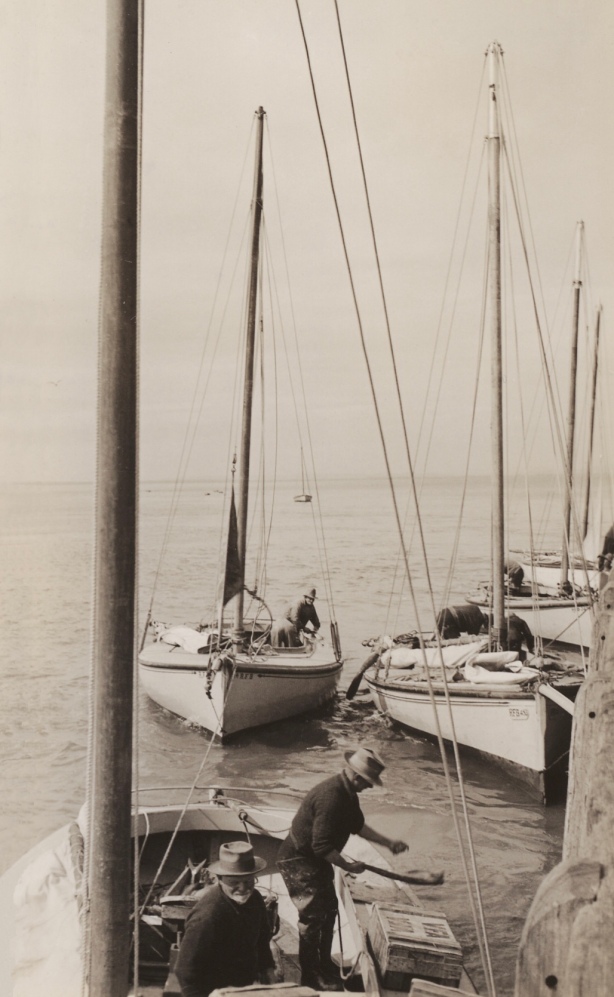

Scott measured the circuit, borrowing a horse and cart. He nailed a strip of rubber to the inside of the wheel and counted the number of times it flicked his boot, multiplying this by the wheel circumference produced the figure of 6.569 miles per lap.
The circuit itself presented a real challenge in that the road was very narrow with a high crown and was extremely dusty- whilst the surface was partially consolidated by blue metal rolled into the gravel it was entirely unsealed.
An inspection of the circuit by 130 Light Car Club members on 4 March revealed a surface in very poor repair. The LCC Committee therefore advised the local council that Commonwealth Oil Refinery and Castrol would provide 5,000 gallons of sump oil to be spread over the track to reduce dust levels. This work was overseen by the COR’s Charlie Watt who found the time to take some of the wonderful photographs spread throughout this article.
Whilst the feature event in 1928 was ‘The 100 Miles Road Race’, when it was discovered that the rights to stage the ‘Australian Grand Prix’, held at Goulburn in 1927, had not been taken up for 1929 the LCC began to apply the AGP term to Phillip Island.
The event was very much an adventure for competitors almost none of whom had road racing experience- their ‘racing’ was variously trials, hillclimbs and in some cases speedway.
Entries closed on 24 February- thirty were received with twenty-six accepted which in the end converted to seventeen starters due to accidents and mechanical mayhem- thirteen cars were manufactured in the UK, eight in France, two in Germany with one apiece from Belgium and Italy.
‘With the exception of one or two entries, the field comprised either standard touring or sports chassis stripped of road equipment and in some instances fitted with narrower and more efficient bodywork…not many modifications were indulged in, other than careful assembly and the polishing of heads and ports and in some instances a slight increase in compression, the use of stronger or double valve springs and the employment of a larger or outside exhaust system’ wrote John Blanden.
Let’s not forget at the time ‘top whack’ of a garden variety Ford, Morris or Citroen was 50-55mph together with a few ‘Hail Marys’ whilst clutching yer St Christopher medallion from father at the wheel.
Plenty of newspaper interest was generated in the ‘big smoke’ (Melbourne) in the lead up to the event with police from later in March turning a blind eye to stripped cars devoid of silencers blasting along the narrow, relatively deserted roads of Melbourne-Frankston-Hastings.
Racing was totally different to today when even production cars are trailered to events. There were no trucks or trailers to take the racers to the meeting, the racing cars were driven by their owners or drivers with spares, consumables and tools loaded into the car- or what wifey, friend or sponsor could carry in a separate vehicle which was then driven to Stony Point and loaded onto the Westernport Shipping Company ferry for the short trip across Westernport.




Phillip Island was then a sleepy rural and fishing hamlet with a nascent tourism industry, accommodation was provided by two hotels- The Isle of Wight and Phillip Island Hotel and a swag a boarding houses which filled up very quickly with the influx of thousands of people the likes of which the Island had never experienced before.
Charlie Watt took many photographs at a hotel which appear to be The Isle of Wight, it burned own the 1925 and was rebuilt in the ‘Tudor’ style one can see in many of the shots- my guess is that the garage shots are at the same establishment- the Phillip Island Hotel appears far more modest in comparison.
The challenges of communication back then were so different to today- the local populace knew when the event was taking place via newspapers but the timing of practice was a different thing without a local radio station even if the punters possessed a ‘wireless’ in any event.
It was hoped that word of mouth and notices on public buildings and shops would do the trick but the possibility of wandering sheep or cattle or Farmer Brown aboard his horse-drawn rig ‘on track’ was not beyond the realms of possibility- a job for the solitary local police constable whose number was bolstered by another couple of souls when police HQ in Russell Street realised the scale of the public event being staged in the Peoples Republic of Phillip Island a couple of hours away from Melbourne.
All was set for first practice on Wednesday 21 March, the first casualty was the SC Cox Bugatti T39 which crashed on the home turn onto the straight- Waite lapped at 57 mph ‘his Austin seemingly on rails’. Official practice took place on the Saturday with Cox’ repaired Bug providing more excitement when it shed a tyre at 90 mph and ‘made a sensational skid at the Bridge of Sighs’. Jack Day did 61 mph in his Bugatti T37. Ed Hussey and Phyllis Passmore’s Frazer Nash took off over a hill, as an escape road after brake failure on the approach to Young and Jacksons- the rear axle had moved forward its springs making the cable operated brakes inoperative…

Bill Williamson’s Riley found a road roller working on the two-mile stretch, skidded and overturned chucking the driver and his passenger out fortunately without injury- the car landed upside down in the bush with radiator, scuttle, tail and steering wheel smashed- by Monday she was ready again to ‘rock and roll’ and looking good as the photograph above shows.
Edward Huon aboard John Goodall’s Aston Martin added to the excitement after shedding a wheel- he too rolled but again the pilot and mechanic, Bob Horne were ok. WH ‘Bill’ Lowe, later importer of Ferrari and Lancia into Australia broke a wheel of his Metallurgique at Heaven Corner whilst Wagner skidded at the same spot after a tyre burst on his Wanderer.
‘Finally Maurice Shmith’s narrow, scarlet Fiat tried to take Young and Jacksons corner too fast, jumped a gutter and plunged through a hedge and a wire fence surrounding a house on the corner. The car was almost immediately shot back onto the roadway by the catapulting effect of the wire fence, fortunately without too much damage to the car and with the passengers only stunned by the suddenness of it all’ John Blanden wrote.
No times from practice are available but doubtless by the end of practice the crews were well aware of the challenges of this simple in some ways, but dangerous and demanding road course.
Unseasonally, the weather gods turned on the Sunday night- raceday was Monday 26 March- the heavens opened completely swamping the course- given the lack of the TV, internet, iPhones, Facebook, WhatsApp or Instagram the Light Car Club decided to hold some flying half mile sprints on the highest, driest straight between Heaven and Young and Jacksons to entertain the crowd who poured in from the mainland on the SS Alvina and Killara. Jack Day’s Bugatti was timed at 84 mph which was the quickest, later in the day the sandy soil dried sufficiently to run and some 3 lap races were organised with Cox scoring a win.






When the field finally assembled on March 31, 1928, the event didn’t attract the number of spectators who attended on The Eight Hours Day long weekend.
‘Nevertheless, the attendance was regarded as highly satisfactory and the racing, although never close enough to be exciting or fast enough to be really thrilling, attracted so much interest that it is likely that the club will make the race an annual event. It is claimed to be the first 100 mile motor race in Australia, ‘The Argus’ newspaper reported .
Of the 26 cars entered 17 started- the Class A capacity limit was 750cc, Class B to 1100cc, Class C to 1500cc and Class D to 2 litres- competitors had to race on Australian made tyres.
Fancied combinations included Ed H Cooper’s Frazer Nash which burst into flames whilst parked in the main street of Cowes and was utterly destroyed despite attempts to extinguish the blaze. The three Bugattis of Jack Day (Type 37A), Sid Cox (Type 39) and Arthur Terdich (T40)- although Arthur Waite’s supercharged Austin 7 was also seen to be an outside chance.
The morning’s race, for Classes B and D, got under way at 11am, with a maximum of two hours 30 minutes allowed to complete the 16 laps.
Barney Dentry’s Senechal was delayed early with a broken gear lever, Williamson’s Riley 9 led for 5 laps then he had mechanical problems giving Bill Terdich’s DFP the lead.
He stayed in front until valve troubles caused his retirement so Barney Dentry, with his gear lever repaired, won Class B from Williamson’s Riley and Pounds DFP.
In Class D John McCutcheon led from start to finish in his Morris Cowley from Cyril Dickason’s Austin 12 in a time of 1hr 50min 10sec – the mark that the afternoon cars would need to beat to win the contest.
The second heat, for Classes A and C, left the line at 3pm and ‘provided the most thrilling driving of the day’, with Waite making the early running, he had a lead of 100 metres at the first turn only a mile from the start.
‘The turning of the small cars on the corners provided many thrills for the spectators. There were spectacular skids, but the cars were always handled with so much skill that the drivers recovered control without apparent difficulty’ The Argus reported, whilst noting that Waite was not in doubt to win Class A.
For the first 7 laps Waite’s Austin led the field, gradually the Bugattis of Day and Terdich got into their stride, with the latter taking the lead on lap 8 and was led by nine minutes as it entered the fifteenth lap, only for the French exotic to stop on course seemingly out of fuel.
Terdich hitched a ride to the pits, returning to the track soon after with tins of fuel only to find that his mechanics had retrieved the Bug and coaxed it back into the pits!
Finally Terdich and his car were reunited and refuelled and sped off in pursuit of Waite who had stopped to refuel, having lost 3 minutes. Day was fast after an excursion early in the race had put him through a hedge, but time ran out for the Bugatti despite a series of laps late in the race of over 70mph.
Waite took the flag in 1hr 46min 40sec and was chaired from his ‘Baby Austin’ as ‘The Argus’ described it, to the victory dais by jubilant supporters.

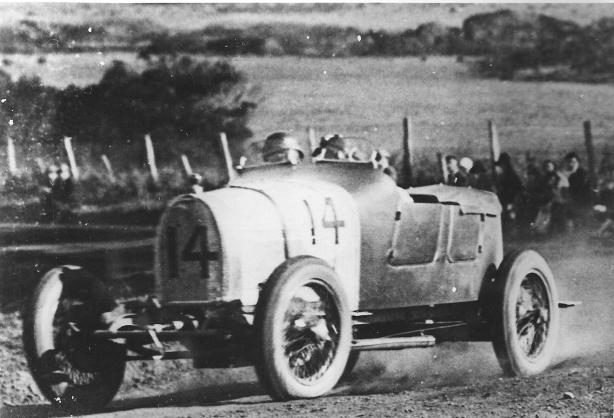


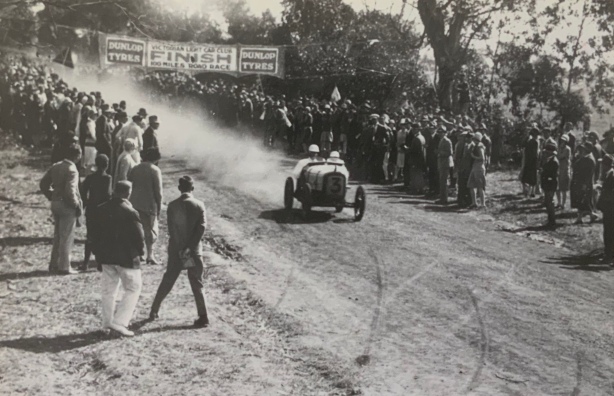
Class A was won by Waite from C May, T Davey and S King all in Austin 7’s, only Waite’s machine was supercharged. In Class B Barney Dentry in his Senechal won from Williamson’s Riley 9 and Les Pound’s DFP. Class C was taken by Terdich’s Bugatti T40 from Day’s Bugatti T37A and the J Hutton Alvis 12/50.
John McCutcheon’s Morris Cowley won Class D despite having more than 21,000 road miles on its odometer! ‘Such performances as these, and that of Mr Hinkler in his British-built light aeroplane, should remove any doubt as to the return of Britain to world leadership in the automotive field’ ‘The Argus’ reported, breathlessly and patriotically- we were a British Dominion then after all!, the Federation of Australia duly noted in 1901. Second in Class D was Cyril Dickason’s Austin 12 and Bill Lowe’s Metallurgique.
‘Probably Waite’s win was due chiefly to his remarkably cool driving throughout and his deliberate stop half way through the race for a methodical refilling of his tiny supercharged Austin with water, oil and petrol. A similar stop would probably have won the race for Arthur Terdich (Bugatti), who seemingly had the race in hand two laps before the finish. Petrol troubles then stopped his car, and Waite won before Terdich got going again…recorded the Geelong Advertiser. ‘Waite won using Shell spirit and oil and Australian made Perdriau tyres’- it was usually the case that the ‘paper reports of the day recorded this information- early advertorial perhaps.

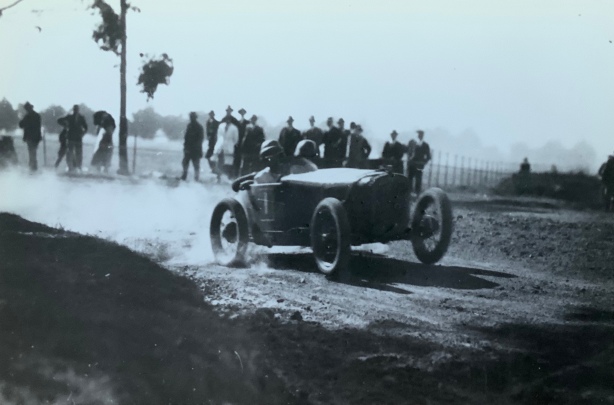
In a word from the sponsor, the Managing Director and owner of Austin Distributors Pty. Ltd. SA Cheney said that ‘…it is pleasing that our confidence in (the Morris and Austin cars the company distributed) their quality and stamina is being so constantly rewarded in successive reliability trials and road contests.’
‘A notable feature of the race was that every Austin which started finished the race. SV King’s car being one of the only three cars to run non-stop, an honour also gained by McCutcheon’s Morris and Dickason’s Austin 12’ the ‘Tiser concluded.
Five thousand spectators went home covered in dust but happy – the largest influx of people in the island’s history, the Shire’s brave decision to back the race was vindicated, the race became a fixture at the ‘Island until 1935 when the intrinsic nature of the gravel track- without change to a sealed surface had run its course.
The winners of the AGP in the Phillip Island era were Bill Thompson in 1930 and 1932 in a Bugatti Type 37 and 1933 aboard a Riley Brooklands. Arthur Terdich won in 1929 in a Bugatti T37A, Carl Junker in 1931 in another Bugatti, a T39, Bob Lea-Wright in a Singer 9 Le Mans in 1934 and finally Les Murphy in an MG P type in 1935. Thompson was second in 1934 and 1935 off scratch and was well and truly the driver of the era, and regarded as one of Australia’s greatest ever. Click here for a piece on Thompson; https://primotipo.com/2018/10/26/gerringong-beach-races-1930-bill-thompson/





The following piece from the fifty year anniversary meeting program of the then first Australian Grand Prix in 1978, was written by John Williams, a journalist who attended and covered the 1928 race.
Do read it, he paints the most marvellous picture of the times and the meeting.
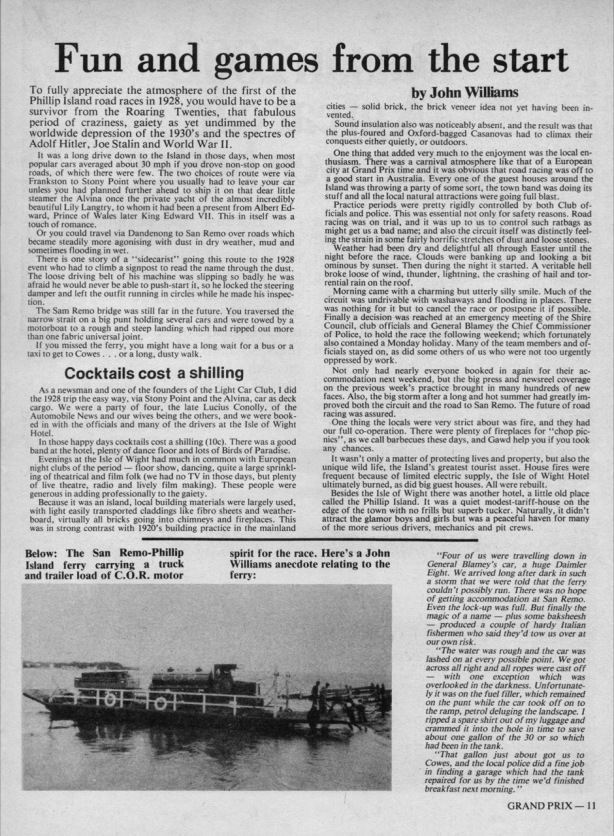
The end of the Phillip Island AGP Era…
Phillip Island’s eighth and final Australian Grand Prix took place in March 1935, it had been decided to rotate the race amongst the states, the 1936 event moved to Victor Harbour, South Australia- the South Australian Centenary Grand Prix held on 26 December 1936, was later erroneously and incorrectly appropriated as the 1937 Australian Grand Prix.
The loss of ‘their’ event was seen as a crushing blow by the Light Car Club, but it was not entirely unexpected, racing on potholed unsealed roads may have been acceptable in the 1920s, but by 1936 it was out of the question, so was the prospect of sealing the Phillip Island track, the economics simply did not stack up.
A new promoter, the ‘Australian Racing Drivers Club’, conducted racing on a shorter 3.3-mile Phillip Island circuit which used only the original start/finish straight (on Berry’s Beach Road) but by 1938 the cars were gone, although motorcycles ran their annual Tourist Trophy on that layout until 1940.
It would be December 1956 before the island saw motor racing action again, this time at a new purpose-built circuit south west of Cowes.




The roads of the Phillip Island road circuit are still intact…
They were clearly marked after the 50 year anniversary of the AGP held in 1978- what an event that was, one for another time.
Its well worth a visit and a few gentle laps amongst the PI tourist traffic, the place is a popular destination for surfers, holiday makers and tourists seeking koalas and the fairy penguin nightly scuttle from the water to their nests in the sand dunes-and of course bike and car enthusiasts visiting the circuit and its museum.
The start/finish area is located on Berry’s Beach Road, the pits used to be located in a large paddock, which today is still a large paddock.
From the start, the road rises slightly to Heaven Corner, the first of the four right-hand, right-angle bends. From here it’s a flat-out blast along the still-narrow undulating high crowned road, past a small monument which has a map of the original track inset into the stone, to Young and Jackson’s Corner, almost two miles away. On your left, a timber plaque displays the corner name, although the original bend is now a large roundabout. Once this is negotiated, another straight (the main road from Cowes back to Melbourne) takes you to within 400 metres of Gentle Annie Corner.
The highway now swings left, so the approach to Gentle Annie is not the original straightforward 90-degree corner, but is clearly signposted and easily found. From here it’s another two-mile roller-coaster ride over the hillocks and humps, encountering The Needle’s Eye at the halfway point, which is no longer a needle, nor an eye.
Hell Corner has recently been obliterated by a roundabout- once you’re through the maze the road stretches out ahead over more gentle rises, with the former Bridge of Sighs at about half distance and the old pits on the left- and that’s it.
In the 1930s the landscape was more barren, caused by the penchant to denude the landscape of trees to allow the maximum number of sheep per acre, and, of course, the road is fully sealed, unlike the days when vast quantities of black sump oil was laid to ‘kill’ the dust

Captain Arthur Waite and his Austin 7…
As we have just see, the 1928 victor was a ‘Baby Austin’, a prototype of the supercharged ‘Super Sports’ package released that year.
Waite was born in Adelaide on 9 April 1984, he lived and attended school in Norwood before attending the Adelaide School of Mines and was then apprenticed to JH Southcott until the outbreak of the Great War.
He joined up and soon achieved the rank of Second-Lieutenant in the Australian Field Artillery, he then took a reduction in rank to ensure his qualification for overseas service- after training in Egypt he landed in Gallipoli on 25 April 1915 also serving in North Africa and France where in 1916 he was awarded the Military Cross
His wife was Irene Austin – daughter of Lord Herbert Austin, founder of Britain’s Austin Motor Company. The pair met during Waite’s War service, he was injured in France and met Irene, a volunteer nurse, during his recovery, they married in 1918 and Waite, an engineer, was introduced into the Austin family business on his twenty-fifth birthday- 9 April 1919.
Waite thought that racing would improve vehicle development and enhance sales, with Herbert Austin’s support he began to develop, build and test racing and sportscars amongst his other responsibilities.
In 1923, together with Alf Depper, foreman of the Experimental and Racing Department the pair drove a 7 to Monza, won the first International Italian Grand Prix for Light Cars on 20 April and then drove home again- success at Brooklands quickly followed when Waite broke all existing 750cc class records.
In 1925 ‘The Skipper’ set up racing ‘shops at Longbridge where work started on the first supercharged 7, this was not initially successful so Austin designed a Roots type blower with three impellers. The blower was mounted on a cradle atop the timing cover utilising magneto drive gear revolving at a quicker engine ratio of 1.25:1- 36 bhp @ 5000 rpm was the result.
Fitted into a 7 foot 3 inch wheelbase chassis with a fabric covered body the car made 92 mph and 86 mph for the two-way flying kilometre. Later that year Waite, with the car bored to 775 cc ran it in the 1100cc class of the 200 Mile Race at Brooklands- along with five other 7s. ‘By the end of 1928 Waite held all the class H (750cc) records’ Bryan Purves wrote
Herbert Austin was keen to broaden his son-in-law’s management experience and shipped him off to Australia to do so, SA Cheney, the owner of Austin Distributors was glad to have him aboard ‘to try and double sales’.
When Waite became aware of the 1928 ‘Island race he requested that his old car be sent to the colonies but unknown to him his supercharged racer, less engine had been sold to Johnny Pares, a Longbridge employee (or dealer depending upon your source), suitably re-engined it raced successfully obtaining the nickname ‘Slippery Anne’ along the way.



Waite was therefore sent a car which was basically a prototype of the ‘Supercharged Sports’ which was going into production to qualify for the Ulster Tourist Trophy.
The chassis of the car (number unknown) was standard as were the springs but they were cord bound- a straight front axle was also standard along with production friction dampers- the steering column was lowered to suit the longer bonnet Waite had made by a coach-builder in Melbourne.
The engine was supercharged, fitted with a Laystall steel crankshaft and pressure lubricated. The Cozette Number 4 blower created a boost of 5psi drawing air from a Cozette carburettor. All of the alloy castings of the engine were prefixed with the letters ‘SP’- the crankcase had the casting number ‘SP767.’
The inlet manifold was designed to slide over long studs and the exhaust was taken out of the nearside bonnet panel via a three-port exhaust manifold which continued along the side of the body. Its output was 33-35 bhp at 5000 rpm which converted to a top speed on the long Phillip Island straights of about 75 mph.
The gearbox was trick too- it was four rather than three speeds but reverse was omitted to find the requisite space inside the standard case.
Austin Works engineer, team manager and driver Charles Goodacre described the completed Waite car ‘As the most dreadful thing you ever saw, for it looked like an enormous egg and when the driver sat in it his head stuck out of the top. Anyway, the whole thing was put together and tested locally instead of being sent to Brooklands. There was a straight stretch of road from Rubery to Bromsgrove over which a local motorcycle company used to test their TT machines at over 100 mph early in the morning…They went there early in the morning when it was safe…I drove it to carry out the road testing and the car had quite a good performance. It would do 90 mph easily and the engine would tun at about 5500 rpm. It was quite smooth, and it was reliable.’
‘Sir Herbert saw the car in the works on his return from South Africa and asked what it was. When told it was the car that was going to Waite in Australia he asked how they proposed sending it and was told they were making a crate for it. “We’re not wasting, time, wood and money on a crate. It looks like a bath, it will float so let the boat tow it to Australia” Austin quipped!
The bathtub which won the Australian Grand Prix it seems!
Two other similar cars were produced by Longridge which were raced by Sidney Holbrook and Gunnar Poppe- entered at Shelsey Walsh, the pair were knocked off by George Coldicutt in ‘Slippery Anne’.
‘Col Waite as well as his other titles was a Freeman of the City of London and a Life member of the British Racing Drivers Club’ Tony Johns added, Johns suggested the inclusion of Waite’s Foreword from John Blanden’s ‘A History of Australian Grand Prix 1928-1939’ which is below.






By the seventies the consensus was that the race winning car had been broken up so Victorian A7 man Bill Sheehan built a replica using the correct type of chassis and running gear with the body built with the assistance of Barry Papps.
Whilst Johns was happily racing his 7 in 500 Car Club/A7 events and divisional racing then later still historic racing he was always on the lookout for A7 bits- especially competition parts.
‘My longtime Meteor bodied Austin 7 friend from Sydney, Col Masterton, told me about the supercharged Waite crankcase. He approached the owner in the hope that i may be able to buy it for my unblown Ulster i purchased in pieces and shipped from the UK in 1974.’
‘It was not for sale but the owner also had a 1930s Nippy sports Austin that was missing its crankcase and if i could find one he would do a swap- it was all stops out to locate a suitable crankcase from my UK contacts so that i could complete the deal.’
‘When the crankcase arrived from England and on my next racing weekend in Sydney…i arranged with Colin to complete the swap. That Saturday morning, under a house not sure where in Sydney i saw the Ulster crankcase for the first time. Imagine my surprise and the look on face trying to stay calm when i realised it was a complete engine including the cast alloy inlet manifold and timing chest at the front of the crankcase. Even the steel gear that drives the supercharger was a special Works part that had one less tooth than the standard part in order to increase the supercharger revs- not just the crankcase that was to be the swap. Racing the Austin in Sydney that weekend became less important, i already had achieved the win of a lifetime.’
‘The Waite motor was reunited with the replica Bill Sheehan constructed replica when it was owned by my friend, Graeme Steinfort- i had sold the eight stud Waite crankcase to Graeme in exchange for legal advice.’
‘At the time Graeme was driving an un-supercharged Ulster he had purchased in the UK from former Lotus F1 driver John Miles. The four speed Waite gearbox was purchased by Graeme from another Melbourne Austin 7 enthusiast, Neil Johannesen’ so the replica at that stage had two of the critical original parts from the 1928 AGP winner.

‘Sydney 1970s when i acquired the Waite engine, unfortunately the spare Blown crankcase was not part of the deal. Note the four bolts on the side face of the crankcase are there to mount the Cozette supercharger. Sydney A7 enthusiast Col Masterton is holding the very rare cast inlet manifold, this differed from later Ulster manifolds as it was designed for the long studs that were used at the time. Note the special 9C numbers that were cast into the non-standard competition parts.’

‘Above is the Waite crankcase after I stripped and cleaned it- the special inlet manifold is clearly visible as well as the original supercharger driveshaft and coupling.’
‘As to the casting numbers you can see, Mike Costigan checked with all the UK experts in relation to casting numbers on the side of the crankcase. The reply was that they were there for the factory to be able to check which foundry had made the castings in case of faults and are of no importance to us regarding Ulster or Super Sports part numbering.’
‘The shot below shows the same inlet manifold, Cozette carburettor and supercharger fitted to my Ulster as above- the crankcase is now, again, as noted above, fitted to the Waite Replica.’
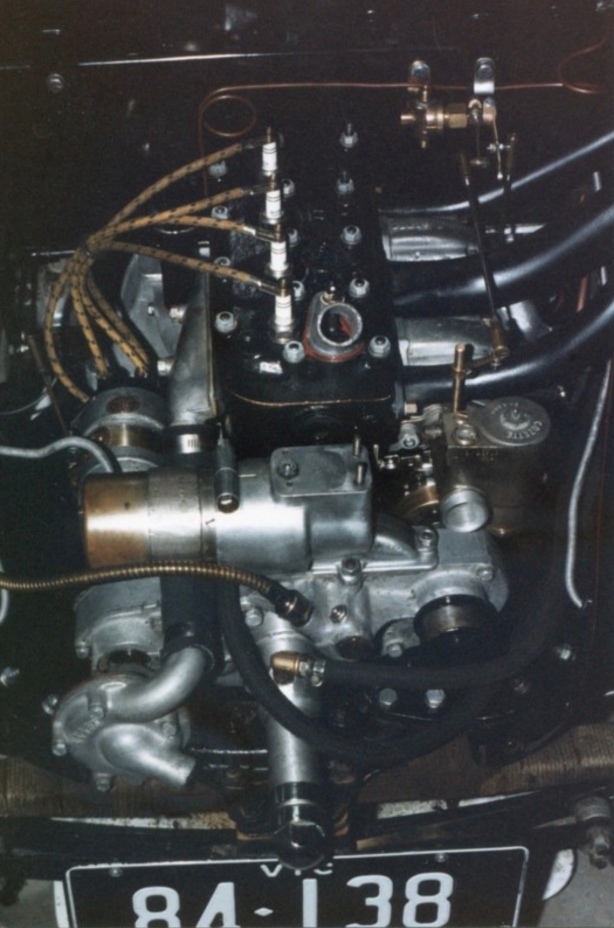
At this point a happy confluence of events occurred, Bob King (remember his ‘Werrangourt Archive’ articles on primotipo) had a next door neighbour at Blairgowrie on Melbourne’s Mornington Peninsula named Reg Sweet who just happened to have owned the Waite car in the late thirties.
‘He was a great bloke, he made a mean home-brew and ensured the whole Blairgowrie experience was bearable. Fascinating too, he had flown as a pilot in Lancasters during the War including sorties over places like Cologne.’
King introduced Sweet to Graeme Steinfort on a Victorian Vintage and Sportscar Club run to Blairgowrie circa 1980, Graeme made typed notes after the meeting- i would scan them and pop them up but they will be too difficult to read hence this transcription in full.
‘Apparently the car had remained in the hands of Austin Distributors in Melbourne for many years after the event (1928 AGP) and was gradually pushed into a corner of their workshop. Reg Sweet at that time was engaged in the motor trade mainly buying and selling Austin 7s, and thus had a lot to do with the people at Austin Distributors. He was onto them for a number of years to sell the car to him, but in those “pre-depreciation” days they said that it was on the books for 200 pounds!’
‘He was called in to Austin Distributors one day in about 1934 and was told that they were clearing out all the old stock and was invited to make an offer on the Waite car if he wished. To this, he requested their suggestion as to what he should offer, and was told “60 pounds”, he offered that amount and acquired the car.’
‘He recalls a lot about the car, the most significant feature which to him, apart from the number 4 Cozette supercharger, was the fact that it would rev quite easily to 7000 rpm in competition. It had the straight front axle and the body on it was quite similar to that constructed by Bill Sheehan (that Graeme owns).
‘Reg proceeded to race the car at Aspendale Speedway (in bayside Melbourne) without success because the days of the Austin 7 in competition were really over, having been overshadowed by the MG P Types and Singer Le Mans which were then the current favourite for light car competition.’
‘However he did have a success in his class at Rob Roy and until recently had a cup to prove it. That cup he donated to Bob King to give as a trophy for Brescia Bugattis at the Bi-Annual Bugatti Rally. Reg tells me he registered the car during this period and ran it without lights or mudguards, the registration authorities in those days being less stringent than they are today.’
‘Basically, however, he used the car purely for competition disposing of it in about 1938 when the responsibilities of family and the like put an end to his sports motoring at the time. Reg managed to break the crankshaft and replaced it with one purchased from England for 13 pounds. The replacement crank came complete with new pistons, rings, gudgeon pins and rods- all fully prepared to go straight into the motor. He tells me the crankshaft was not an exact fit and he had to do some work on the case, grinding a proportion away to get the crankshaft to fit. Tony Johns reports that these grinding marks are present on the crankcase that he has on his engine.’
Graeme Steinfort concludes an amazing document with the observation that ‘Naturally, Reg remembers the car with some affection and would like to have it back today! I think we join with him in that, and it would be nice to see the complete car in existence.’
Tony did some quick Rob Roy research and indeed Reginald Sweet won class 1, under 750cc, supercharged at Rob Roy Number 5, Cup Day November 1938 with a time of 41.66 seconds- he returned on 30 January 1939 and finished second in class to Derry George, MG J4 who did a 38.74 seconds.
If any of you can fill in the gaps between Reg Sweet’s sale of the Waite car circa 1938 and the acquisition of the car’s engine and gearbox by Messrs Johns and Steinfort in the seventies that would be wonderful, do get in touch.



Arthur Waite provides his best wishes to the Austin 7 ‘Raid’ racers prior to their trip to the UK in 1981.
Prominent Australian historian/racing journalist Ray Bell provided this shot below which his brother took in the UK in 1987- Ray wrote the 1928 chapter, and others, of ‘The 50 Year History of The Australian Grand Prix’, Bell’s copy of which Arthur is holding.
Ray dispatched his brother to meet with the old racer to sign the 1928 title page of his HAGP copy, when brother Brian knocked on the door and sought an audience, or arrived at the agreed time, the lady who answered the door enquired as to the reason for calling to which Brian responded ‘He won a car race in Australia a long time ago’ at which point the lady interrupted him by saying ‘Yes! And haven’t we all heard enough about that?’

Etcetera…


Stan King Austin 7- unusual angle shows the tight packaging of mechanic and driver in the smaller cars- the pair completed the second race for Class A/C cars without a stop, one of few to do 100 miles without pitting.
Good deed of the day award went to this crew who gave Arthur Terdich a lift on the rear of the car as the hapless Melburnian tried to find his Bugatti which had been coaxed back to life by the side of the road and driven back to the pits by his mechanic.

John McCutcheon and friends before the off- the second placed and very quick Morris Cowley was never headed once into the lead of the morning’s Class B and D race.
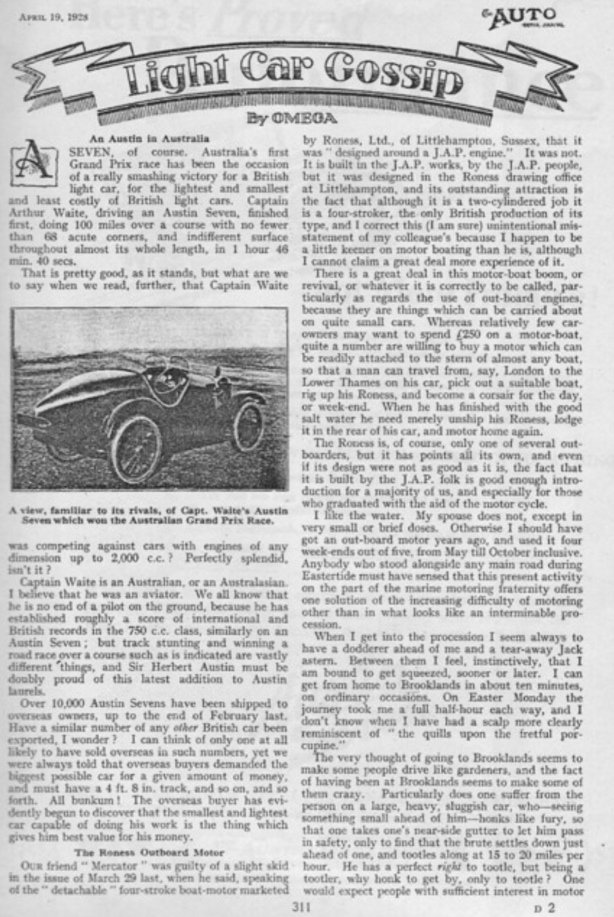

The Pound DFP in profile- Les was third in Class B despite a number of tyre blowouts in the morning race, Bill Terdich in the other DFP was a DNF with a broken valve or piston.

Light Car Club committee members at the Isle of Wight during the 1928 meeting. The fellow on the car side closest to the umbrella pole is Arthur Terdich, Tony believes- any clues on the other characters folks?
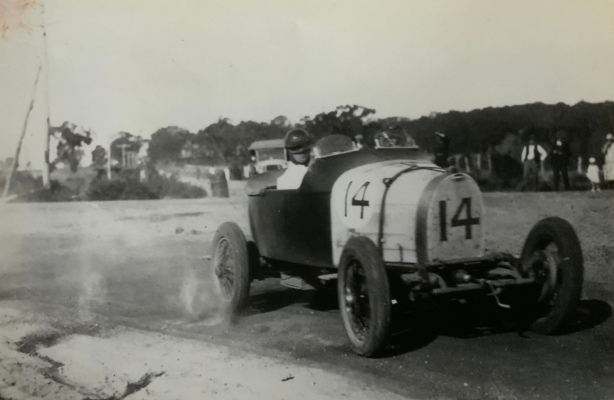
Arthur Terdich was in many ways the ‘man of the meeting’ having been up to his armpits in the organisation of the event as a LCC Committe member and one of the front runners in the race- he was stiff not to win it.
He returned to the Island many times of course and won in 1929 with a Grand Prix Type 37A Bugatti rather than the modified touring T40 machine he drove so well in 1928.
Terdich was a critical force in Victorian racing for many years, I will circle back to him and have a crack at a profile about him with Bob and Tony’s assistance.
In the sensational photograph below Terdich (left) is plotting the path of the 1926 Alpine Trial, the car is his 3 litre Bentley chassis ‘602’, which was also the official course car during the event, somewhere in the Victorian high country.


Bill Williamson, aboard the Riley 9 owned by Mrs Jack Day.
It was a weekend of drama with a rollover in practice and a class B/D race of perseverance after transmission problems caused a pitstop- during which the problem was fixed, twelfth the result.


Barney Dentry does look like a lean, mean fighting machine, despite the fag.
So many of these early racers were middle-aged given the readies required to compete, Barney is a veritable youth in comparison- car is a Senechal.

A Valentine postcard of the Isle of Wight over a race weekend- not much to go on but cars and a date folks?

Gee-whizz, the Phillip Island Hotel looks decidedly low rent, I doubt any of the Light Car Club types stayed there.

Les Jennings, Morris Cowley DNF after completing 6 laps- the car blew a cylinder head gasket.
His Lanes Motors supported machines were very well prepared with support from Lanes- and very well driven.

‘Dunlop Grand Prix this way’- by this stage of the journey to Cowes the spectators would have been at fever pitch with excitement at the prospect of a spectacle few would have seen before- Terdich behind the wheel of the road roller?

Ron Gardner with a touch of the opposites, Alvis 12/50- DNF after completing 8 laps- big end bearing failure.

The John Goodall Aston Martin 1.5- Ed Huon the driver and Bob Horne the mechanic- Goodall retired the car with stripped gears having only completed a lap of the afternoon race.


Not too many racing cars and drivers have been honoured with an Australian postage stamp- but the Waite Austin 7 s/c is one of them.
The Australia Post researchers got it right too- the other car featured is the ‘if only’ Bugatti T40 of Arthur Terdich.
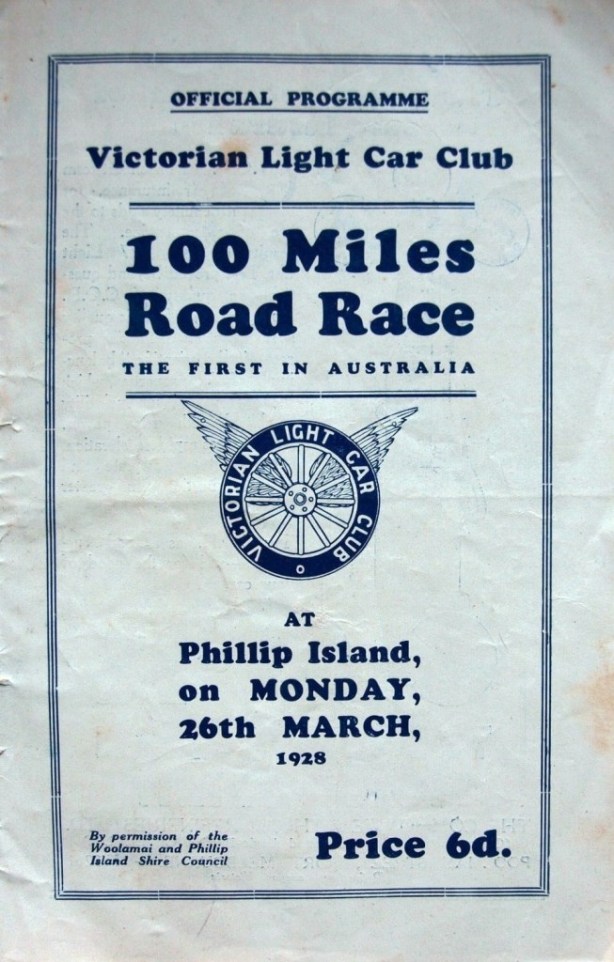


As reported in period by ‘The Car’…










The Austin Distributors Pty. Ltd. Melbourne dealership with all staff on deck by the look of it out front of 460 Bourke Street just before the race.
We are not sure if this shot was taken in 1928 or 1929 but it’s not so much the date as the vibe.
Bibliography…
‘The Austin Seven Source Book’ Bryan Purves, Bill Sheehan, Austin 7 Club Australia website, Jim Scaysbrook article in MotorSport magazine February 2008, speedwayandroadracinghistory.com, The Nostalgia Forum, The ‘Goulburn Evening Penny Post’ 17 January 1927, ‘The Sydney Sportsman’ 22 November 1927, ‘A History of Australian Grand Prix 1928-1939’ John Blanden, ‘History of The Australian Grand Prix’ Graham Howard and others, Tony Johns recollections, ‘The Advertiser’ Geelong 3 April 1928, article by Philip Turner about Charles Goodacre in Motor- 17 February 1973 issue, ‘Vintage Bentleys in Australia’ P Schudmak, T Johns and others, ‘The Car’ article via T Johns Collection, Arthur Waite Collection via David Howe
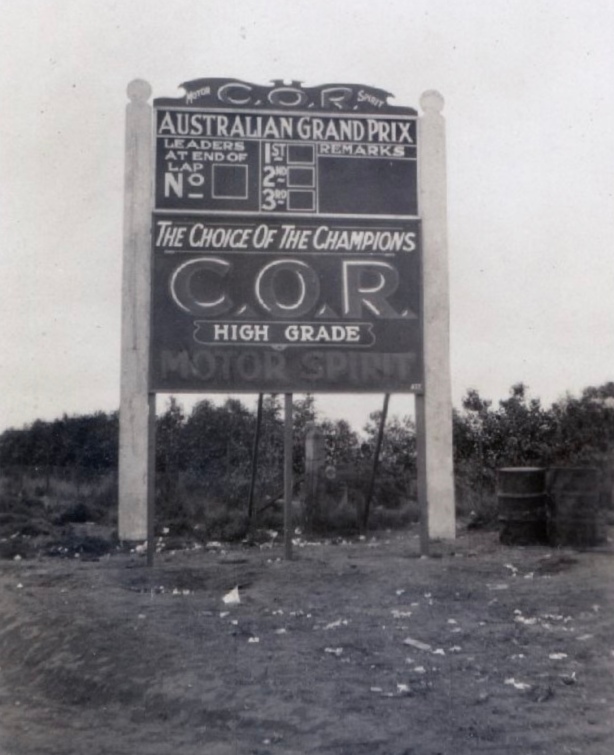
Photo Credits and notes…
Tony Johns, Tony Johns Collection, Bob King Collection, Graeme Steinfort, MotorSport, Edwin Adamson, ‘Austin Racing History’ Roland Harrison, Edgar Family, The Bugatti Trust, Stephen Dalton Collection, Ray Bell Collection, ‘Making Cars at Longbridge’ Bardsley and Corke
Charlie Watt provided many of the photographs in this article via Tony Johns who comments as follows, ‘In the early sixties i met Charles ‘Charlie’ Watt of Brighton, Melbourne who had a lathe in his garage and helped with some machining on my Austin.’
’He worked for COR and was very pleased to pass his photos on to a young enthusiast, several of the photos (in this piece) have been published under others names- it would make me feel better if Charlie finally received some acknowledgment for his work.’
‘Charlie was also responsible for the COR scoreboard above. He damaged his hand with its construction and still had issues with it in 1960. His son Bruce built a special, named after his girlfriend and later raced a Valiant or Falcon on gas in a Sandown endurance race- the Bruce Watt of Benalla Auto Club fame?’
Many thanks to the late Charlie Watt for his photos and to Tony for sharing them.
It was amusing sitting down with Bob King at his place in Brighton earlier in the week and learning that Ray Bell, a mate who wrote the 1928 AGP chapter in HAGP, sat beside Bob in the same study circa 1984 whilst Ray made his choice of photographs from Bob’s Collection which was largely accumulated in the long research process of writing various Bugatti books- i can imagine Ray sitting there twisting from buttock to buttock, frustrated trying to work out which of the over forty shots to use with a page count limit to work to- as you have probably worked out i have no such restrictions!
The end I think.
Tailpiece…

The Castrol depot at the Island in 1928 – car folks?
Finito…




